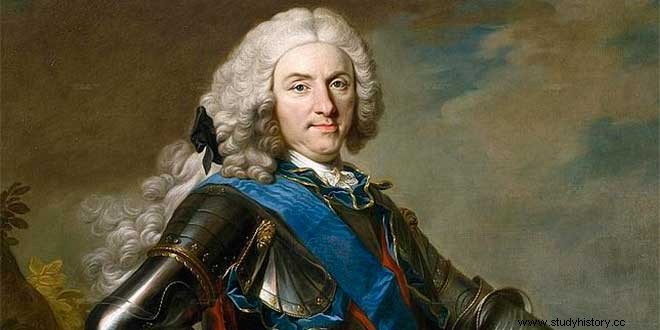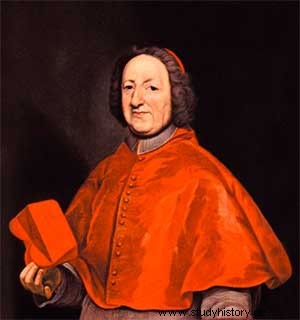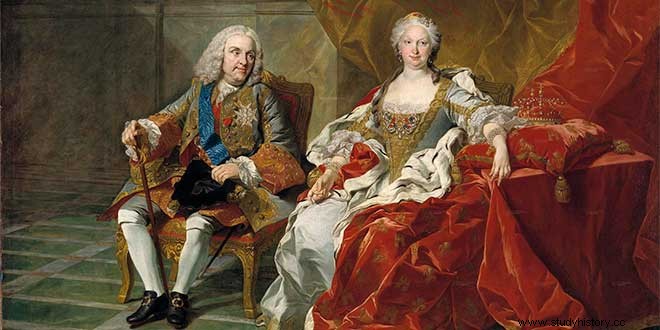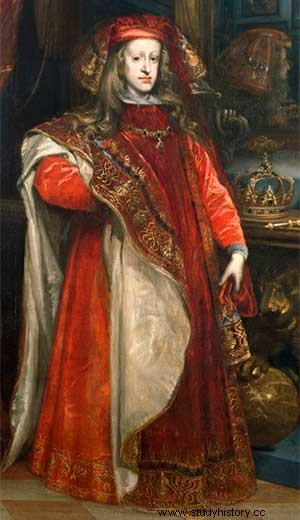Isabel de Farnesio, queen of Spain, second wife of Felipe V de Borbón and mother of Carlos III, was one of the most notable women of the 18th century . After the fall of the Habsburgs and the consolidation of the Bourbons, at the beginning of the century, a conflictive era opened up for Spain, of losses and recoveries, of collapse and rebirth, which was marked by his influence and her ambition. Isabel de Farnese meant the end of the predominant influence of France in the kingdom and its supplanting by Italian interests.
Important events in the life of Isabel de Farnesio
1692 She is born in Parma.
1714 She married by proxy with Felipe V de Borbón and subsequent coronation of her as queen of Spain.
1746 Death of Felipe V. Succession of Fernando VI, stepson of Isabel, and Bárbara de Braganza. Retreat in San Ildefonso.
1759 Brief regency of Isabel between the death of Fernando VI and the assumption of Carlos III, her eldest son.
1766 Isabel de Farnese dies in Aranjuez.
End of French influence in Spain
The end of the War of Succession, which strengthened the Bourbons on the Spanish throne, and the death of Queen María Luisa Gabriela de Saboya closed the first period of the reign of Felipe V . Until then, the Spanish monarch had been little more than a viceroy of his grandfather, the absolutist Louis XIV, who, using his faithful collaborators in the Castilian court, supervised his every move. In this sense, and despite the energy shown by his wife, it can be said that during that first phase the one who really reigned from the shadows was the princess of the Ursinos, the strongest instrument of the Sun King. But, in February of 1714, Felipe's sudden widowhood would be the triggering factor that would alter the situation definitively . It was undoubtedly the desire for power of advisers and courtiers that precipitated the marriage agreement that would put an end to the extensive French influence, sweeping away the pretensions of almost all those who saw in the union a new means of asserting themselves. The blindness of the princess of the Ursinos and the vision of Count Alberoni played the decisive roles in this story whose main protagonist was Isabel de Farnese, the second Bourbon queen of Spain and one of the most notable women of the 18th century.

The second queen, Elizabeth of Farnese
Originally from Orvieto, the Farnese family gave Europe governors, captains, a pope, and several dukes of Parma. Born in that city in 1692, Isabel was the daughter of Duke Edward III and Dorotea Sofía, Duchess of Bavaria . She was educated in a secluded room of the ducal palace under the constant surveillance of a strict and authoritarian mother, she practically did not know the outside world until she came of age. She had, however, a certain worldly air about her. Domineering and haughty by nature, her best gift was knowing how to curb that arrogance whenever she wanted, dressing her dominant and violent character with grace and sympathy. Of a cultivated spirit, her great fondness for the fine arts not only inclined her to paint, but she also developed in her a high aesthetic criterion that was manifested even in the choice of her her attrezzo , which notably enhanced a rather insignificant physique. She knew history and politics more deeply than women of her day and was fluent in several languages. That cultural preparation, her poise and her charm were the weapons of her seduction:the best means of fueling unlimited ambition.
Julio Alberoni, an ally of Isabel de Farnesio

To reign in Spain, she only needed the mediation of Julio Alberoni, one of the strangest characters in the court of Felipe V and as greedy as her . The son of a gardener from Plasencia, he had come to the peninsula as a kind of buffoon for the Duke of Vendóme during the War of Succession and acquired a certain popularity for being a specialist in picaresque-style jokes. He was also an excellent cook. When his mistress died, he managed to be appointed delegate of the Duke of Parma in Madrid. Shortly after, when the king was widowed, he saw before him the opportunity of his life:if he managed to marry Philip V to the daughter of the Duke of Parmesan, his future would be assured. And time was in charge of showing that, in addition to being a cook and a jester, Alberoni had other skills, since he was a skilful statesman and became a cardinal. But at that time, to achieve his goals, he had to convince the person with the greatest ascendancy over the monarch, and this was none other than the fearsome princess of the Ursinos.
Princess of the Ursines
Now in her seventies, the princess of the Ursinos maintained the same momentum shown throughout her existence and that had made her one of the most extraordinary figures on the stage of the time. Sent by Louis XIV in 1701 to control the newly married young monarchs —Philip and Maria Luisa were then seventeen and fourteen years old—, it was she who indirectly ruled, exerting almost total influence over the couple . Her name was actually Anne Marie de la Trémouille and she was born in Paris in 1642. Eldest daughter of the Duke of Noirmontiers, she married the Prince of Chaláis at the age of seventeen, who was expelled by the Sun King because of his participation in a duel. Refugees first in Madrid and later in Rome, the princess, already a widow, remarried at the age of thirty-three with Flavio Orsini, Duke of Bracciano, turning from that moment the Orsini palace into the center of French influence in Italy. She was soon widowed again and kept her husband's surname, but changed her title to princess, and she continued to devote herself more and more intensely to politics. She resumed her old friendship with the Marquise de Maintenon, the wife of Louis XIV, and came to have so much power that through her influence and her intrigues ambassadors and cardinals were relieved of their posts> . When she arrived at the Spanish court she castellanized her name, in the same way that Farnese became Farnese.
Election of Isabel de Farnese as Queen of Spain
Alberoni knew that the princess wanted a noble, young and docile girl for the king who would allow him to continue exercising her customary influence unhindered, and managed to convince her that Isabel was the one for her , because in addition to meeting those conditions, her modesty and disinterest were alarming. The cunning Italian, therefore, spoke the exact words the princess wanted to hear. The link was made by proxy, in Parma, on September 16, and before the end of 1714 the new queen was already on her throne. Elizabeth was twenty-two years old at the time. After having met her at his palace, on a stopover on the way to Madrid, the Prince of Monaco, in a letter addressed to the Marquis de Torcy, described her as follows:«Of medium height and a well-formed body, she has the elongated face with some signs of smallpox and also small scars, but all this does not make her ugly. Her eyes are blue and, although not very large, they are very lively and expressive. Her mouth, which is very large, reveals admirable teeth, as she smiles frequently. Her voice is charming and her conversation is very pleasant. She is friendly and courteous. She likes music very much, she sings and paints quite well, she rides horses and is fond of hunting. Spanish is the only language that she does not speak. She is Milanese by heart and Florentine by intelligence, she has a great strength of character » .
End of the influence of the Ursine Princess
After another stopover in Pau, where her aunt, the widow of King Charles II, was waiting for her, she finally arrived in Jadraque a few hours later than expected. This delay infuriated the princess of the Ursines, who by way of greeting scolded her and scornfully criticized her figure. As an answer, Isabel called Alberoni and energetically ordered him to take away «that crazy woman who has dared to insult me» ; Alberoni obeyed him and the princess ended up being arrested, leaving him to take her place. When Felipe found out about the incident, he sided with his wife and the intelligent princess had to go into exile, defeated by a «docile» girl and a gardener's son, ending her career.

Beginning of Isabel de Farnesio's influence
Defeated and the fact that she would have been her greatest threat, the queen's next step was to dominate her husband, and she did not take long to achieve it, although in this case she used seduction. She began by meekly seconding every act of the king until she won his admiration and his trust, and once she obtained it she had no difficulty in imposing on him.
her criteria. The annals of the court are eloquent in this regard:Isabel accompanied Felipe on her hunts, dressed in a masculine suit, arousing the king's astonishment at her style and her aim. She other times she encouraged the troops, also appearing dressed in knightly clothes, mounted on horseback and carrying two pistols, showing unusual courage in a woman. With these actions she defied public opinion but achieved the enthusiasm of her husband. The French influence was gradually declining, and although in some aspects already rooted in customs it continued to manifest itself, in others it was replaced by the Italian, and in this the queen herself and Count Alberoni were the main inspirers . However, when they built the Palace of San Ildefonso, the Palace of Versailles was taken as a model. And this became the favorite residence of the kings. But it can be said that Spain was completely emancipated from French influence when Louis XIV died on September 1, 1715.
The filial kingdom
Isabel de Farnese's policy was channeled, even before the birth of her seven children, to assure them a future crown. The Spanish throne would correspond, perhaps to the premature death of Philip V, to the children of her first marriage. This was the reason that fueled, on the one hand, her excessive ambition, and on the other, perhaps, the manifest animosity she felt for her three stepchildren. The youngest of them, Felipe Pedro, died before he was seven years old, in 1719; but Luis and Fernando were still the legitimate heirs of her husband. With her help, then, first from her Italian ministers Giudice and Alberoni, and, once he was removed, with that of the even more ambitious Baron Ripperdá, she channeled all her energies into achieving her goals. Although her company was crowned by her success, it can be inferred that she did not contribute anything to the aggrandizement of Spain, from which her domestic policy was notably neglected. Count Alberoni, for his part, although he did cooperate in it by means of several projects of great importance for the peninsula, exceeded his powers, and that overreaching earned him, at first, failure —because of his intrigues, the Quadruple Alliance was born between England , the emperor, France and Holland against Spain—, his immediate exile.
Isabel de Farnese's shadow government
Elizabeth, meanwhile, as the well-known melancholy of the king degenerated into madness, she acquired more and more power, until it was only she who directed the government . And she did so purposefully but discreetly. She behind closed doors she seconded her husband in the most crazy extravagances, even when she had to change her own habits. In front of the others —his subjects including courtiers and ministers, foreigners, his relatives— he always maintained the feint of normality that corresponded to two monarchs at the head of a State, disguising the imbalance of the king and, as much as possible, trying to appear neutral. The truth is that when in January 1724 Felipe decided to abdicate in favor of his son Luis, she could not dissuade him despite his dominance. But even this event contrary to his designs would end up being favorable to him and in a very short term, since Luis I died that same year and Felipe, despite his refusal, was practically forced by her to occupy the throne again, and in this way Elizabeth continued to reign, in fact, until her husband's death twenty years later. By then she had already seen most of her dreams crystallize.
Treaties to favor the children of Isabel de Farnesio
In 1725 the Treaty of Vienna was signed, managed by Ripperdá, which confirmed the investiture of his eldest son Carlos —born in 1716— for the titles of the Italian duchies of Parma and Plasencia, the first positive result of his revisionist policy. And although France, England, Holland and Prussia, respecting the Treaty of Utrecht, signed an opposition pact that same year in Hannover, they would end up recognizing, through the Treaty of Seville of 1729, the right of their son.
Two years later the emperor also accepts the Spanish policy and Carlos takes possession of the duchies from him. Soon, his intervention in the War of the Polish Succession allowed him to occupy the throne of Naples (1734). Likewise, the incursion into the Austrian succession dispute (1740-1748) would return the Italian duchies to his domain, by virtue of the Aachen Agreement, by which his second son, Felipe (1720), took possession of them. .
His other children, except Francisco (1717), who died shortly after birth, also enjoyed other thrones:María Ana Victoria (1718) was queen of Portugal; María Teresa (1726), married to the dauphin Luis, was from France; Luis Antonio (1727) was archbishop of Toledo and primate of Spain, and only the youngest of his daughters, María Antonia, would die unmarried (1729-1785).

Removal of Isabel de Farnesio from the court
After the death of the king in 1746, Isabel de Farnesio was removed from the court by his successor, his stepson Fernando VI, and for the next twelve years he lived in San Ildefonso, near the remains of Felipe V. Already made to his habits, she continued to sleep during the day and get up at night, and if at first she was seen on her nocturnal walks through the palace gardens, in later years she hardly left her bedroom. Everything indicated that her death was near. However, she would still surprise everyone once again. When Ferdinand VI died, as soon as she received the news and the powers for the regency, she traveled by car fourteen leagues on a bad road to be in Madrid one day and occupy the throne:the death of the king had restored her life . She governed the country for less than four months, from August 17 until the long-awaited arrival of Carlos, on December 9, 1759, to be crowned Carlos III. Isabel, who was seeing her son again after twenty-eight years of separation, hoped from that moment to stay by her side. Charles III preferred—perhaps anticipating her mother's intervention in affairs of state—to keep her away from court shortly after taking charge of her kingdom. Isabel de Farnesio lived from then on in Aranjuez, where she would die six years later, on July 11, 1766, as a result of the Esquiladle mutiny.
